Orange and black is Gigabyte's chosen colour scheme for the Z270N-Gaming 5 and the overall aesthetic is considerably different to the previous-generation Z170N-Gaming 5. The new aesthetic is an improvement – the orange is unique and sets the motherboard apart while the new rear I/O shroud and heatsink design is much tidier.
RGB lighting is provided as a multi-zone implementation near the rear I/O and PCIe lanes while a 12v G R B W header is also provided for connecting LED strips.
Connectivity on the motherboard is sufficient, USB 2.0 and 3.0 headers are provided along with four SATA ports. Gigabyte takes an awful lot of space for a connection dubbed OCT_CON, meant to connect an optional OC touch panel. We think, for the price point, it's unlikely users will buy this optional extra and as such Gigabyte could have put the space to considerably better use.
All three fan headers are located near the CPU 8 pin and each one is controlled by a Nuvoton 3947S IC. Gigabyte offers solid fan controls, even if the default fan profiles are too aggressive, and the flexibility is such that users can control any 3 or 4 pin fan in PWM or DC mode.
Gigabyte wastes yet more space with a debug port that serves no obvious function to end users. Some of this wasted space could have been spent putting in a debug code reader, power buttons or other more useful features.
Near the USB 3.0 port is a cluster of other connections including a clear CMOS header and chassis intrusion header, but the 2-pin LED Demo port serves no obvious purpose and its inclusion seems unwarranted. Again, why include connections the consumer will not be able to do anything useful with?
There is also 5 pin LED header which is in the format 12v G R B W, the W (White) being an additional pin that most other motherboards do not include, this sits near a speaker header and the colour-coded front panel connections.
The CPU socket is paired to a well-equipped power delivery system that looks to be a 6+2 phase design.
Underneath the primary CPU VRM heatsink, there are six power phases each with its own Infineon IR3553M IC. Further round the CPU socket another two phases are set up with the same IC configuration. Near the rear I/O is the primary Infineon controller, an IR35201, which controls the 6+2 power phase operation.
We also found six Richtek RT9018B and two Richtek RT8120D voltage regulators which we presume further contribute to voltage regulation for the motherboard.
The rear I/O feels light on USB with 6 ports; MSI's Z270i Pro Gaming Carbon AC has the same USB configuration while the ASUS ROG Strix Z270i Gaming adds two more USB ports. In Gigabyte's case they are all USB 3.0 or higher. The Type-C and above Type-A port are both USB 3.1 Gen 2 and are powered by an ASMedia ASM2142 IC. Gigabyte also provides a legacy keyboard and mouse combo port.
Display outputs are covered by HDMI 1.4 and DisplayPort 1.2 while networking is handled by two WiFi antennae and an Intel Gigabit LAN powered by the I219V controller. The audio, disappointingly, has just three audio jacks while rival motherboard vendors use 5 analogue jacks and an optical port.
Overall the I/O is a little bit thin due to the sparse audio connections and lack of USB ports. Gigabyte also miss a trick by not offering any BIOS flashback or clear CMOS buttons to fill the large gap at the back.
Underneath the Gigabyte Z270N-Gaming 5 is where the M.2 drive is meant to be mounted. We found that Gigabyte placed it too close to the CPU socket and as such we struggled to fit our M.2 test drive in next to Corsair's standard H100i v2 backplate. In the end it fit but was forced in at an angle and under considerable pressure which is not viable for a long term solution but sufficient for us to complete benchmarking.
This problem wasn't experienced on any other motherboard thus far so we think this is a design oversight from Gigabyte. A real shame because these days consumers shouldn't have to worry about such petty things as compatibility between M.2 drives and a backplate. There's also no consideration given to M.2 cooling for high performance drives – Gigabyte's solution relies entirely on ambient airflow.
 KitGuru KitGuru.net – Tech News | Hardware News | Hardware Reviews | IOS | Mobile | Gaming | Graphics Cards
KitGuru KitGuru.net – Tech News | Hardware News | Hardware Reviews | IOS | Mobile | Gaming | Graphics Cards


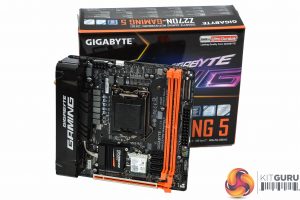
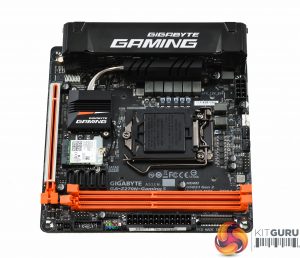
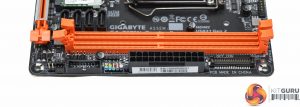
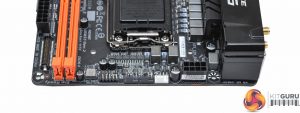
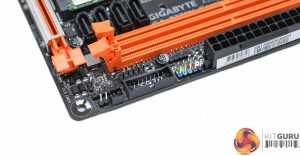
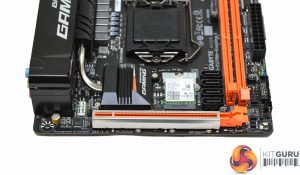
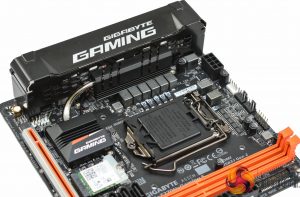
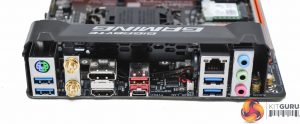


Just bought this board (2017-07) and without issuing a notice or a revision number change, it appears they have fixed the m.2 issue. I installed a Samsung EVO m.2 drive, and a Corsair H60 backplate, and there was plenty of room between the two. Matched the placement I’ve seen in pictures from other boards like the z270 WiFi from gigabyte. Cheers